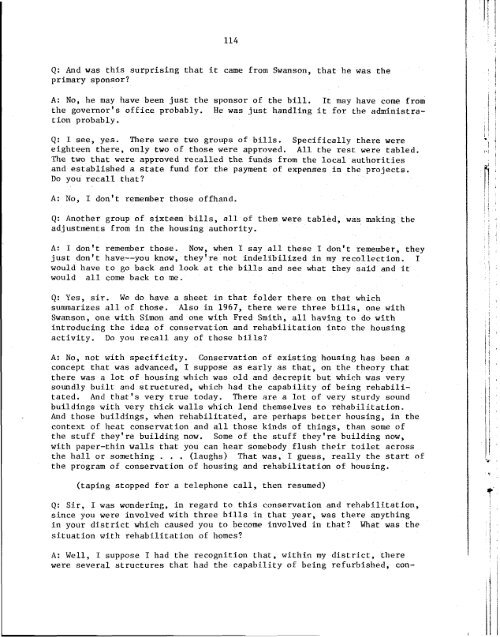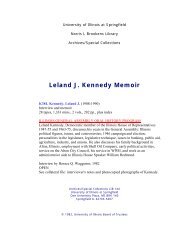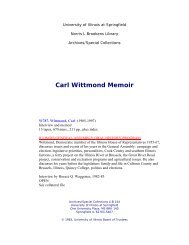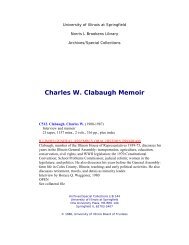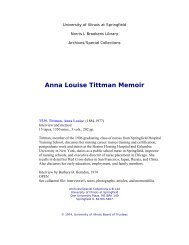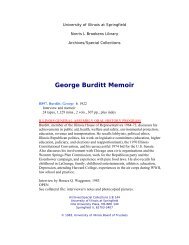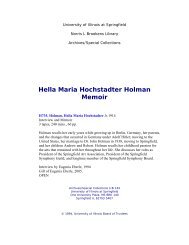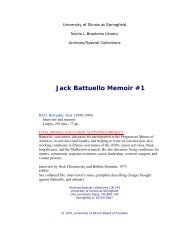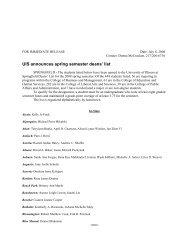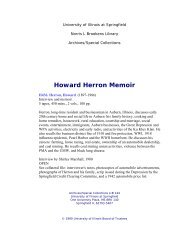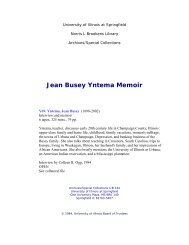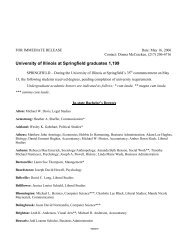Cecil A. Partee Memoir - University of Illinois Springfield
Cecil A. Partee Memoir - University of Illinois Springfield
Cecil A. Partee Memoir - University of Illinois Springfield
You also want an ePaper? Increase the reach of your titles
YUMPU automatically turns print PDFs into web optimized ePapers that Google loves.
Q: And was this surprising that it came from Swanson, that he was the<br />
primary sponsor?<br />
A: No, he may have been just the sponsor <strong>of</strong> the bill. It may have came from<br />
the governor's <strong>of</strong>fice probably. He was just handling it for the administration<br />
probably.<br />
Q: I see, yes. There were two groups <strong>of</strong> bills. Specifically there were<br />
eighteen there, only two <strong>of</strong> those were approved. All the rest were tabled.<br />
The two that were approved recalled the funds from the local authorities<br />
and established a state fund for the payment <strong>of</strong> expenses in the projects.<br />
Do you recall that?<br />
A: No, I don't remember those <strong>of</strong>fhand,<br />
Q: Another group <strong>of</strong> sixteen bills, all <strong>of</strong> them were tabled, was making the<br />
adjustments from in the housing authority.<br />
A: I don't remember those. Now, when I say all these I don't remember, they<br />
just don't have--you know, they're not indelibilized in my recollection. T<br />
would have to go back and look at the bills and see what they said and it<br />
would a11 come back to me.<br />
Q: Yes, sir. We do have a sheet in that folder there on that which<br />
summarizes all <strong>of</strong> those. Also in 1967, there were three bills, one with<br />
Swanson, one with Simon and one with Fred Smith, all having to do with<br />
introducing the idea <strong>of</strong> conservation and rehabilitation into the housing<br />
activity. Do you recall any <strong>of</strong> those bills?<br />
A: No, not with specificity. Conservation <strong>of</strong> existing housing has been a<br />
concept that was advanced, I suppose as early as that, on the theory that<br />
there was a lot <strong>of</strong> housing which was old and decrepit but which was very<br />
soundly built and structured, which had the capability <strong>of</strong> being rehabilitated.<br />
And that's very true today. There are a lot <strong>of</strong> very sturdy sound<br />
buildings with very thick walls which lend themselves to rehabilitation.<br />
And those buildings, when rehabilitated, are perhaps better housing, in the<br />
context <strong>of</strong> heat conservation and all those kinds <strong>of</strong> things, than some <strong>of</strong><br />
the stuff they're building now. Some <strong>of</strong> the stuff they're building now,<br />
with paper-thin walls that you can hear somebody flush their toilet across<br />
the hall or something . . . (laughs) That was, I guess, really the start <strong>of</strong><br />
the program <strong>of</strong> conservation <strong>of</strong> housing and rehabilitation <strong>of</strong> housing.<br />
(taping stopped for a telephone call, then resumed)<br />
Q: Sir, I was wondering, in regard to this conservation and rehabilitation,<br />
since you were involved with three bllls in that year, was there anything<br />
in your district which caused you to become involved in that? What was the<br />
situation with rehabilitation <strong>of</strong> homes?<br />
A: Well, I suppose I had the recognition that, within my district, there<br />
were several structures that had the capability <strong>of</strong> being refurbished, con-


